#Trypillia culture
Explore tagged Tumblr posts
Text

Top: Clay figurines, Trypillia culture, first half of the 4th millennium BCE, Sushivka village, Cherkasy region, Ukraine
Bottom: Model of the dwelling, Trypillia culture, first half of the 4th millennium BCE, Kolomyishchyna-2, Kyiv region, Ukraine
#and how cool is that?#from the collection of national museum of the history of ukraine#ukraine#ukrainian art#artwork#ukrainian history#art history#art#trypillian archaeological culture#Trypillia#trypillia culture#ceramics
25 notes
·
View notes
Text
my first attempt at grappling with complicated geometric design


it took me 2 lessosn to paint it whole, so about 4 hours... and it's not a good painting job. i've always hated and avoided as much as possible geometric designs, patterns that need to be executed with precision and symmetry. but it's time to change that. it's the first time i tried it, so it's not looking great. but after painting 10 pots i will become more experienced, and my lines more clean and sharp
details:


pattern is very loosed based, or maybe rather inspired by the beautiful pottery of the Cucuteni Trypillia culture, really fascinating neolithic culture that was lucky to occupy incredibly fertile lands of modern day Ukraine during a period of very favorable climat conditions. so they were rich and egalitarian, they lived in giant proto cities that were burned down every couple of decades, in multi storey wooden houses. there is a lot of depictions of women on their pottery, and female figurines, clay figurines of women sitting on thrones....

it's unfired yet, i will fire it in a pit once i visit my aunt's house in the countryside :) it looks white now, but will change colour later. the clay i used is purified clay used for brick production, so it will be orange, just like these 2 pieces:

#pottery#archaeology#replica#neolithic#cucuteni tripillia culture#prehistory#cucuteni trypole#cucuteni culture#tripolye culture#trypillia culture#blurry photos taken from my laptop bc my phone is out of order#my pottery#my pic#things i made#moje#experimental archaeology#me#stuff i made#earthenware
12 notes
·
View notes
Text
Scientists were wrong for many years: the first cities of mankind did not arise in Mesopotamia, but in Ukraine.
The Swiss newspaper Neue Zürcher Zeitung writes about it. The publication notes that for decades, there was no doubt in archaeology that the first cities of mankind arose around 3800 BC in Mesopotamia, on the territory of modern Iraq. Only there, it seemed certain, were thousands of people living together in a small space at that time.
Now, this obvious dogma is being shaken: archaeologists are investigating settlements that existed as early as 4000 BC. In the 1st century BC, this territory reached an area of up to 320 hectares, which is three times the area of the old city of Bern, and in which more than 10 thousand people could live. They were not in Mesopotamia - but in Ukraine. They show how different archaeologists can use the same material to develop diametrically opposed narratives about the past.

In the mid-1960s, military topographer Konstyantyn Shyshkin was studying aerial photographs of Ukraine and noticed a shadow. If you look closely, you can see the shadow even today. This happens because plants in fields receive more or less nutrients and water in some places than in others. Archaeological remains are hidden underground in these places. Where there was once a ditch, the roots penetrate deeper into the ground, and the plants grow higher. If the roots rest against the stones, then the stems become shorter. These features of the vegetation were arranged in such a way that it made the natural geological basis unlikely - it was in the form of concentric circles. Here, obviously, there were man-made structures in the ground. Aerial photos only give clues, then they must be verified on the ground. But it is impossible to fully excavate an area of several hundred hectares. In 1971, Ukrainian scientists began a large-scale research campaign on some of these objects using a method that was just being developed in archaeology - geomagnetism.
It is based on measuring very small changes in the Earth's magnetic field that are caused by structures hidden in the ground and the iron particles they contain. This method still requires manual labor today, but the devices measure continuously, so it is much faster than it was 50 years ago in Ukraine.
In a short time, it was possible to determine the size of the settlement, which was only dimly visible on aerial photographs. From this time and this region until that time, mainly ceramics, vessels made of yellowish clay with decorations of geometric patterns and curved lines, the so-called Kukuten-Trypil ceramics, were known.
The question arose before archaeologists: Why did people 6,000 years ago on the territory of modern Ukraine create planned settlements that were larger than any other that existed anywhere in Europe at that time? Why didn't they just continue to live their lives in small rural communities, as they had done before and as they would do again later? It took almost 3,000 years for settlements of comparable size to reappear on the territory of modern Ukraine, then Greek colonists founded cities on the Black Sea coast.
2 notes
·
View notes
Text
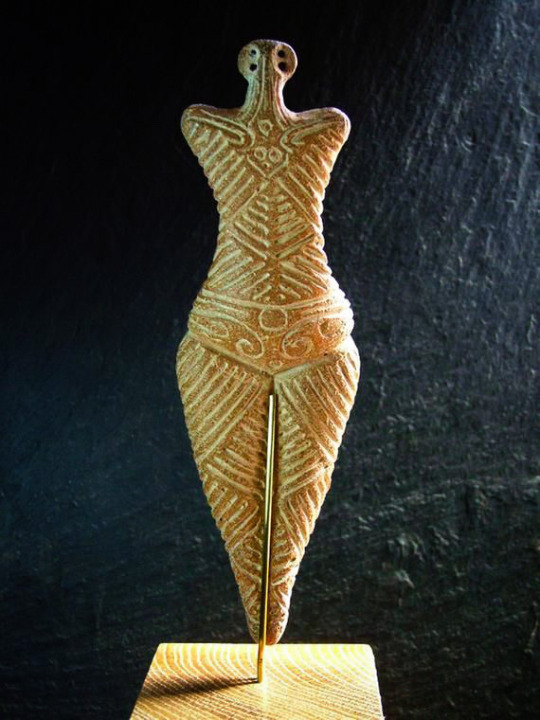
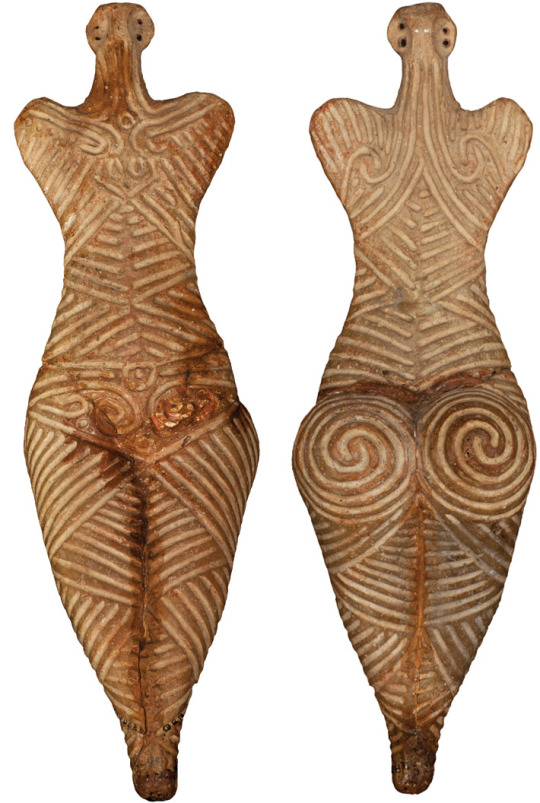
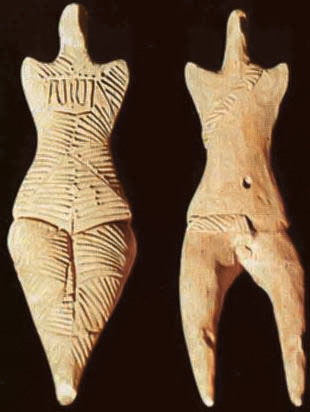

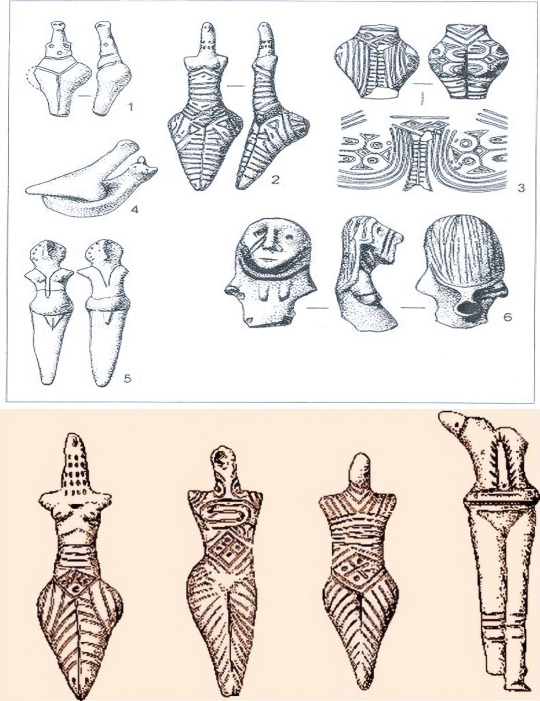
#Trypillia Culture#Google Arts & Culture#6th millenium BCE#europe#culture#ancient ways#sacred ways#Goddess#Cucuteni#Ancestors Alive#What is Remembered Lives#Memory & Spirit of Place#sculpture#figurines#moldova#Cucuteni-Trypillia Culture
4 notes
·
View notes
Text
Cucuteni–Trypillia culture
The Cucuteni–Trypillia culture, also known as the Cucuteni culture or the Trypillia culture, is a Neolithic–Chalcolithic archaeological culture (c. 5500 to 2750 BC) of Southeast Europe. It extended from the Carpathian Mountains to the Dniester and Dnieper regions, centered on modern-day Moldova and covering substantial parts of western Ukraine and northeastern Romania, encompassing an area of 350,000 km2 (140,000 sq mi), with a diameter of 500 km (300 mi; roughly from Kyiv in the northeast to Brașov in the southwest). Wikipedia
#phys.org#Ukraina#Moldova#Cucuteni–Trypillia culture#Trypillia culture#Trypillia settlements#Europe#Mega sites#Mega settlement#Vegetables#Agriculture#farmers#farming#Neolithic technology
1 note
·
View note
Text

Model of reconstruction of a dwelling of the Aeneolithic Trypillian culture, Tomashevskaya local group. Approx. 3700 BC. The item is on display at the Kiev Archaeological Museum.
#arts and crafts#handmade#handmadeartwork#tumblr artist#crafts#artists on tumblr#archaic ancient crafts history panel primitive pyrography traditionalart woodworking historyart#historyart#ancient history#history#archeology#architecture#museum#culture#reconstruction#my art#Trypillia culture#український#український tumblr#tumblr українською#Трипільська культура#craft
1 note
·
View note
Text
Time Travel Question 52: Medievalish and Earlier
These Questions are the result of suggestions a the previous iteration. This category may include suggestions made too late to fall into the correct earlier time grouping. In some cases a culture lasted a really long time and I grouped them by whether it was likely the later or earlier grouping made the most sense with the information I had.
Please add new suggestions below if you have them for future consideration. All cultures and time periods welcome.
We already did the burnings which lost their bracket, but the culture lasted a long time across a big area, and people keep suggesting it.
#Time Travel#Passenger Pigeons#Extinct Species#Birds#North American History#Natural History#Pleistocene#Aotearoa#Moa#Haast's Eagle#Indigenous History#Māori History#Māori Folklore#Māori#Silphium#Ancient World#Neolithic#Cucuteni–Trypillia Culture#Kazakhstan#Archaeology#Bronze Age#History of Disease#Fiber Art#neanderthal#homins#Early humans#History of Fashion
263 notes
·
View notes
Text
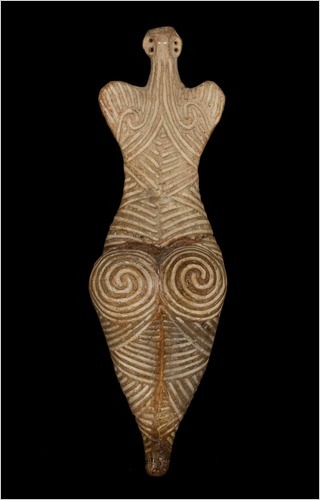
Goddess figurine (4050–3900 BC), Romania
#goddess#Romania#Cucuteni Trypillia culture#Cucuteni Trypillia#art#Miss Cromwell#Stone Age#neolithic#ancient history#figurine#matriarchy
306 notes
·
View notes
Text
Hah! Super interesting site. Wonderful ceramics. (The original report is in German.)
52 notes
·
View notes
Text
2 notes
·
View notes
Text

Disk calendar, 23rd - 15th cent. BCE, Bortnychi village, Kyiv, Ukraine
#art history#art#ukraine#ukrainian art#artwork#support ukraine#history#ukrainian history#ceramics#trypillian archaeological culture#trypillian culture#trypillya#trypillia#archaeology#from the national museum of the history of ukraine collection
33 notes
·
View notes
Text
the cucuteni-trypillia culture were the only people who really had it figured out
no social stratification or division of labor
spend all day doing farm shit or making sculptures of hot women
every 70 years burn your entire city to the ground and rebuild it all from scratch
#cucuteni-trypillian posting#neolithic posting#fuck the greeks and romans and what have you. the cucuteni-trypillia culture is the only ancient people i look up to
4 notes
·
View notes
Text
Huh, so I had no idea Trypillian house burnings are such a rabbit hole. It's always seemed such a small detail to me in comparison with the sheer mass of innovations they had, but apparently it's an entire warren in itself. There was a lot of experimental archaeology done with that building burning... Pretty fun stuff!
To all curious, enjoy these experimental pictures - just note that the site these are linked from is an amateur history webpage and there is... A LOT that isn't reliable on there. I'm not even sure which exact experiment this is from without further reading, for instance.


Second Poll.
Third Poll.
Fourth poll.
#for future reading#til the burning of buildings in trypillian culture is considered a historical mystery#but yeah they're considered “ritual” which is archaeologist slang for “yeah we don't know about any practical meaning for it”#there's a lot of interesting things about trypillia#there's a reason a lot of newcomers to that area of history latch on to it#and in the amateur parts of it it's just myth after myth#my archaeologist friend is telling me that there's a lot of arguments about two separate fire traces#one careful and seemingly made to proof and the other to take them down#and whether the walls and in some cases roof could possibly have been sort of ceramic#and then burned when time came to take 'em down
14K notes
·
View notes
Text
#Trypillia Culture#Google Arts & Culture#6th millenium BCE#europe#culture#ancient ways#sacred ways#Goddess#Cucuteni#Ancestors Alive#What is Remembered Lives#Memory & Spirit of Place#sculpture#figurines#moldova#Cucuteni-Trypillia Culture
1 note
·
View note
Text
The earliest cities in Europe were built on the foundations of a mostly vegetarian diet, according to new research. The findings suggest that even with the dawn of agriculture and large, planned settlements, meat was but a delicacy. The gigantic circular cities of the Trypillia culture emerged around 6,000 years ago in what is now Ukraine and Moldova.
Continue Reading.
101 notes
·
View notes
Text
Concept: a Bad Boy romance novel set in the Romanian/Ukrainian steppeland around 2800 BCE, where the protagonist is a clay-working Earth-Mother-worshiping weaver/hoe farmer from the Cucuteni–Trypillia culture and the Exotic Bad Boy is an hyper-patriarchal, wolf-themed, Sky-Father-worshiping raider from the Yamnaya culture
The actual story is written like every trashy romance novel ever, but a third of the wordcount is in obsessively-detailed footnotes giving archaeological sources for the shape of pottery and the genetics of crops, and half the dialogue is untranslated reconstructed Proto-Indo-European
47 notes
·
View notes